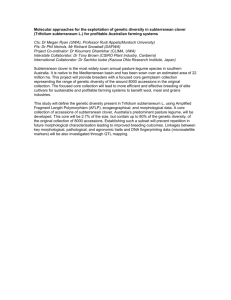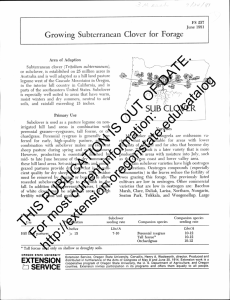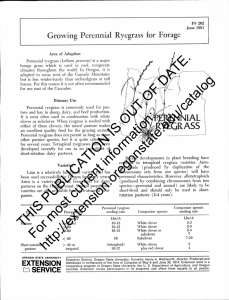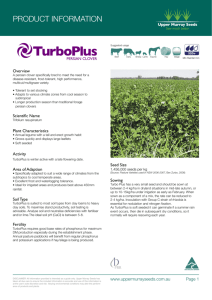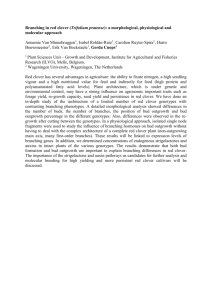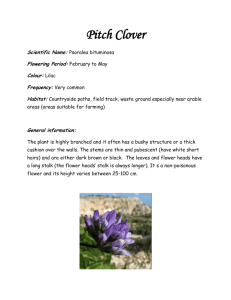LIGHT LAND PASTURES
advertisement
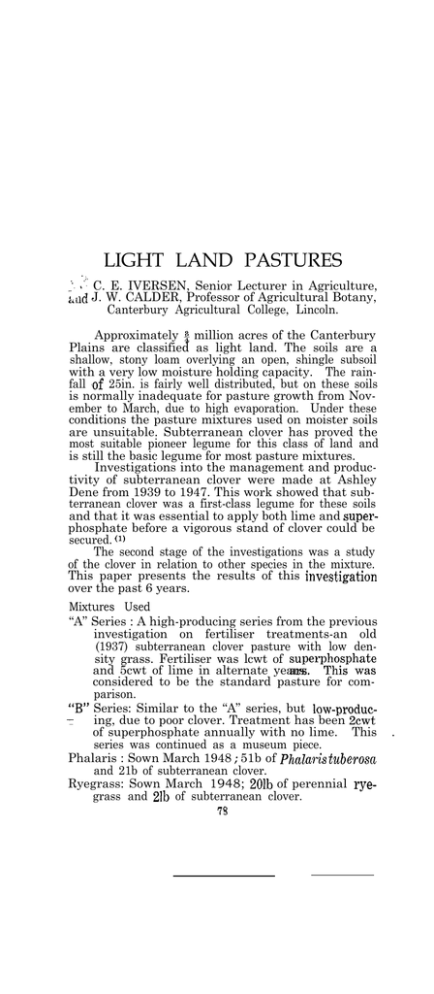
LIGHT LAND PASTURES .‘, i”‘ C. E. IVERSEN, Senior Lecturer in Agriculture, aLid J. W. CALDER, Professor of Agricultural Botany, Canterbury Agricultural College, Lincoln. Approximately 8 million acres of the Canterbury Plains are classified as light land. The soils are a shallow, stony loam overlying an open, shingle subsoil with a very low moisture holding capacity. The rainfall ,of 25in. is fairly well distributed, but on these soils is normally inadequate for pasture growth from November to March, due to high evaporation. Under these conditions the pasture mixtures used on moister soils are unsuitable. Subterranean clover has proved the most suitable pioneer legume for this class of land and is still the basic legume for most pasture mixtures. Investigations into the management and productivity of subterranean clover were made at Ashley Dene from 1939 to 1947. This work showed that subterranean clover was a first-class legume for these soils and that it was essential to apply both lime and superphosphate before a vigorous stand of clover could be secured. (1) The second stage of the investigations was a study of the clover in relation to other species in the mixture. This paper presents the results of this invest.igation over the past 6 years. Mixtures Used “A” Series : A high-producing series from the previous investigation on fertiliser treatments-an old (1937) subterranean clover pasture with low density grass. Fertiliser was lcwt of super$;;;h;.; and 5cwt of lime in alternate years. considered to be the standard pasture for comparison. “B” Series: Similar to the “A” series, but low-produc7 ing, due to poor clover. Treatment has been 2cwt of superphosphate annually with no lime. This series was continued as a museum piece. Phalaris : Sown March 1948 ; 51b of Phalaq-is tuberosa and 21b of subterranean clover. Ryegrass: Sown March 1948; 201b of perennial ryegrass and 21b of subterranean clover. 75 . Cocksfoot: Sown March 1948; 1Olb of cocksfoot and 21b of subterranean clover. Lucerne-Phalaris : Sown September 1949 ; IOlb of lucerne, 51b of phalaris, and 21b of subterranean clover. Top-worked Ryegrass: The ryegrass fields had become weak in clover by 1953 and one field was topworked in ,February 1953 and 1954. Fertiliser treatments for all except “B” series were the same as for the “A” series. On this class of land there is a very slow establishment phase and the results presented herein are given from autumn 1950 to summer 1956. Autumn (March, April, May) is taken as the commencement of a season, as the annual subterranean clover germinates at that time and the season is partly .governed by the vigour of the germination. Weather data for the 6 years under review are given in Table 1. Table l--Weather Data 1950-56, Lincoln College Year Rainfall 1950-51 1951-52 35.15 1952-53 1953-64 1954-55 1955-56 31.00 30.86 27.25 21.67 21.61 (in.) Evaporation 25.17 27.84 25.28 22.09 30.17 32.47 Two-thirds of the pasture production of these soils is made in the spring months of September, October, and November and consequently annual rainfall and evaporation are not necessarily correlated with production. Spring moisture, on the other hand, gives an accurate picture of productivity. This is shown in Table 2, where spring rainfall and potential transpiration calculated according to Penman’s@) formula are compared with the average production of all plots. If the spring rainfall were evenly distributed throughout the 3 months, a net moisture of zero should give maximum production. This is obviously not the case. However, Penman’s factor of .7 may be too low under the conditions and the estimated soil surplus may be too high. Before examining the results of using different mixtures a consideration of the strengths and weaknesses of the standard pasture is desirable. The stand79 ard subterranean clover pasture as typified by the “A” series is a high-producing sward and many of the mixtures tried have failed to reach the same production. Table S-Spring Moisture and Production , Year 1950 1951 1952 1953 1954 1955 EvapoNet s;G&g transpiraMoisture (in.) tion (in.) -~ ____~~~ _I~_ (in.) _ _ _ 6.59 7.60 -0.01 5.49 7.51 -1.02 11.48 6.68 + 5.80 5.57 5.67 to.90 3.63 9i42 4.79 4.39 7.98 -2.59 Annual Pasture Production 1950-56 --100 ~__114 75 162 120 .53 62 Winter soil moisture surplus = lin. The essential features of the sward are as follows : A low density of perennial species and a high density of annual species. The average percentage of constituents over the 6 years is: Percent Subterranean clover - 31 Perennial grasses, mainly ryegrass - ‘31 Annual weeds and weed grasses 38 The low density of perennials has an important bearing on germination of the clover in autumn. 2 . Spring production is 66 per cent of the total and requires special flock management, such as early lambing and early drafting of light-weight lambs and provision of supplementary feed for winter and early spring. 3 . Annual production is very variable (coefficient of variability 55 per cent). The main variation is in clover growth. In an average season the clover germinates in the early autumn and is well established by winter. A small winter growth is followed by an intense spring flush which dies off in November but provides paddock roughage for the. summer. Flowering occurs from early October and results in a reasonable build-up of seed in the soil. In wet seasons 4 ton per acre of seed’ may be set but in dry seasons the clover may dry off before seed is set. This is important in a new pasture, but is normally of little consequence in an old pas1. 80 I - MAXIMUM h MINIMUM PRODUCTION OF ‘A’ Maximum SERIES Product ion I Stock Requirements .-’ -*7 / i \ A. S. 0: N. D. J. F M. A. M J J. ture where regeneration can occur from hard seed. If autumn moisture is unfavourable, seed may fail to germinate; it may germinate early and fail to survive or germinate late and be killed by frost lift. A legume less subject to the vagaries of climate would be of value. In Table 3 the seasonal production of the “A” series is given for the period 1950-56. When related to the weather data in Tables 1 and 2, together with the factor of germination discussed above, the reasons for variability in production are 81 - Table 3--Seasonal Production “A” Series 1950-56. Seasons Autumn Summer Winter Spring lb of dry matter ___~__ - -____~ 666 433 1950 1313 387 81 1460 232 Total -__ 1950-51 1951-52 Year 1952-53 1953-54 1954-55 10 245 103 4362 2160 6018 4070 921 2266 3300 1955-56 144 1950-56 293 Percentage production 9% 20 297 39 168 373 4366 2948 422 2181 1622 380 357 16 653 6% 66% 20% 1938 apparent. Although average production is high, the extreme variability and the poor seasonal spread justify the search for superior species. In one respect subterranean clover rates highly, that is, as a stock’ feed. We have as -yet found no nutritional troubles with these swards. A comparison of the different mixtures used is therefore made on the basis of average production, variability, seasonal production, and nutritional value. Average Production Table 4 gives the average production of the 7 mixtures for the years 1950-56. AVERAGE PRODUCTION OF A SERIES TO STOCK REQUIREMENTS lb d.m. per doy A S. 0. N. D. J. 82 F M A. M. J J. Table I-Average Production of Seven Mixtures, Field 18, Ashley ‘Dene, 1950-56 Yield in lb dry matter per acre Sown Subterranean ‘Clover Total Mixture Grass Weed Lucerne ---..--- _ _ ~~__ _ _ _ -___. ____-1 . Phalaris . 126’7 925 625 2817 2 . “A” series , 1007 1268 1025 3300 3 . “B” series . 355 1115 180 1650 4 . Lucerne-Phalaris . 1613 728 607 162’7 4575 5 . Ryegrass - 1428 587 610 2625 6 . Cocksfoot (1) 1328 497 511 2336 7 . Top-worked ryegrsss (2) 850 1230 1310 3390 (1) For seasons 1950-53 only. Adjusted to 6-year average. (2) For seasons 1953-55 only. Adjusted to 6-year average. Significant difference of totals at 5% = 826 Significant difference of totals at 1% = 1142 Comments on Table 4 Only one mixture is superior to the “A” series, i.e. lucerne-phalaris-subterranean clover mixture. This has been significantly better in each of the 6 years. The contribution of sown grasses, weeds, and subterranean clover at 29481b is about average, but superimposed on this is a yield of 16271b of lucerne. The differences in yield of the 7 mixtures are largely accounted for by differences in yield of the legumes. The “A” series with a low density of perennial grass usually has a high percentage of clover, as does the top-worked ryegrass for the same reason. The mixtures with a high density perennial grass such as cocksfoot and ryegrass inhibit the germination of subterranean clover in all except the most favourable autumns and consequently are low in clover. The “B” series, being inadequately fertilised for clover, is seriously affected in clover growth and growth of sown grasses. “Weeds” consist of hair grass, sweet vernal, and such plants as storksbill. These are at a minimum in swards of high density perennial grasses. Annual Variability It was noted above that the “A” series had a coefficient of variability of 55 per cent. It was expected that the use ,of perennial grasses would reduce variability considerably, as such mixtures are less subject 83 to vagaries of germination. However, a compensating factor occurs with the legume. With high density grasses subterranean clover is even more unreliable and the low’nitrogen status lowers grass production. The perennial legume lucerne is least subject to annual variation. The coefficient of variability of the principal mixtures is : Per cent Phalaris - 58 Lucerne-phalaris 39 Ryegrass - 50 The cocksfoot mixture is low in variability, but achieves this by being uniformly poor. Seasonal Production Table 5 gives the seasonal production of the principal mixtures as percentages of the mixture totals, but for comparison the actual yield should be, taken into account. Table 5-Percentage Seasonal Production of Six Mixtures, 1950-1956 Mixture Autumn _...__~ _---Phalaris 14 “A” series - 9 Lucerne-phalaris - 12 Ryegrass - 12 Cocksfoot - 15 Top-worked ryegrass 5 Winter Spring Summer 9 5 10 3 3 13 55 66 54 62 56 69 22 20 24 23 26 13 The use of different species has tended to spread production. Phalaris has some advantages for autumn and winter production, as is shown in both the phalaris and lucerne-phalaris mixtures. Lucerne gives good summer production ; cocksfoot is valuable in summer and autumn, but is inferior in winter. The best general pattern is given by the lucerne-phalaris-subtcrranean clover mixture. Nutritional Value The two species about which there may be ‘some reservations are phalaris and lucerne. Where phalaris forms a major portion of the diet stock health may be affected, but in the mixture used here there have been no noticeable adverse effects. V. R. Clark commenced a field trial of some of these mixtures in 1954. Ewes and lambs were used for grazing and records’ kept of fat lamb production. The two seasons of the trial to date have been dry. A wet season may show up defici84 in the nutritional value of the lucerne mixture, but so far the lucerne mixture has carried more ewes and lambs and the daily weight gainper lamb has been as good as on other mixtures. The dry matter production of the three fields is given in Table 6, as it confirms on a field scale the evidence from plot work presented earlier. en&s Table 6-Production of Three Light Land Pastures 1954-55. (in lb dry matter per acre) 1954-55 , Field Winter Spring Summer Autumn Total 1. Ryegrass pasture ’ first year - 1164 2. Ryegrass pasture second year 62 3. Lucerne, phalaris, subteranean clover eighth year - 352 1955-56 1. Ryegrass pasture second year 258 2. Ryegrass pasture third year 63 3. Lucerne, phalaris, subterranean clover ninth year - 336 1417 405 238 3224 217 339 341 959 1703 1061 iI 3647 556 39 3 2 6 ” 1169 469 50 531 1113 3067 421 i90 4014 The ryegrass pasture is a standard mixture for this class of land. It shows up well in the first winter and spring, but in the second and third year in dry seasons tends to become cloverless. When most of the ryegrass has died the clover will gradually thicken up and give a good pasture akin to the “A” series. The lucerne pasture used in this trial was sown in 1947 with 31b of Medicago glutinosa, 51b of phalaris, and 21b of subterranean clover. M. glutinosa is a rhizomatous strain with a low crown and good sward-forming characteristics. ,In this field it provides 70 per cent of the total production and its performance has encouraged us to embark on a programme of selection and breeding with the species. Discwkion Initial Pasture Improvement : The establishment of high-producing swards of subterranean clover ‘and a Perennial grass on this class of land is possible but difficult. The standard mixture of a’ high density 85 grass such as one bushel of ‘ryegrass gives a good firstyear growth, but then passes through a low-producing cloverless phase for .several years. This can be prevented in one of four ways. In the more difficult environments a pure sowing of subterranean clover can be made in autumn. Greenfed oats may be added without harm. October grazing should be avoided. A good seed setting should result and in the absence of competition a good germination should be secured the following autumn. A light seeding of grasses can be surface introduced into the sward within a few years. On better land the grass component can be broadcast in front of the drill and the clover drilled with the manure. Such a sowing gives a scattered grass component akin to the “A” series. Where they are drilled together, a suggested mixture is 51b of perennial ryegrass, llb of cocksfoot, and 31b of phalaris with 41b of subterranean clover ; 21b of short-rotation ryegrass may be added to provide competition for weeds in the initial stages and for winter production, and *lb of white clover to take advantage of any subsequent build-up in fertility. Where ryegrass is to be cut for seed in the first year a heavier seeding may be used. In the absence of grazing there is a good seeding of clover and the ryegrass is weakened by seed production. Pasture Renovation. Old pastures of subterranean clover which may have become grass or weed dominant due to the build-up of nitrogen can be renovated by top-working in January. The field is quickly worked with grubber or discs and harrows and rolled down to conserve moisture. If considered desirable a light seeding of grass may be drilled in. Where winter and early spring feed are desired, 10lb of short-rotation ryegrass can be sown with advantage. Lucerne Pastures. Lucerne has been used increasingly on these soils, but mainly as a source of hay with a little grazing. While this still has an important place, we believe there should be a development of lucerne pasture mixtures devoted almost entirely to grazing. The lucerne mixture used in these investigations has given 40 per cent more production than the next best mixture and 100 per cent more than some of the high density perennial grass mixtures. It has a lower variability due to vagaries of climate and has a better seasonal spread. In a well-balanced mixture nutritional troubles have not been apparent. A combination of subterranean clover, cocksfoot, and phalaris with the lucerne appears to be suitable. 86 The strain of lucerne to be used is the matter of some controversy. An early sativa strain is very productive ‘and its early spring growth is valuable at lambing. With careful grazing it will last in the sward for many years. M. glutinosa is later in spring, but has sward-forming characteristics which permit .severe and continued grazing in times of scarcity of feed. It has shown greater longevity under these conditions than M. sativa. A compromise may be to include both strains in the mixture. Success can be achieved with several seed mixtures, e.g., (a) 81b Marlborough lucerne , 21b cocksfoot 41b subterranean clover. (b) Sib Marlborough lucerne 31b M. glutinosa 21b cocksfoot 31b phalaris 41b subterranean clover. (c) 41b M. glutinosa 21b cocksfoot 21b perennial ryegrass 21b short-rotation ryegrass Jib white clover 41b subterranean clover. Variations may be made within these. Such mixtures are best sown in the spring after a winter fallow; late September is most suitable in this district. The subterranean clover is an important component of the mixture and with spring sowing it may fail to set seed. In this event it should be oversown the following autumn. However, our view is that the pioneer stage of development of the lighter lands is the establishment of good subterranean clover pastures akin to the “A” series. Once fertility has been built up in this way the stage is set for a higher phase of production with the lucerne pasture. Acknowledgments This investigation was made possible by a financial grant from the Department of. Scientific and Industrial Research to whom grateful acknowledgment is . made. We are also indebted to the College Board of Governors who provided land, stock, and labour, and to the Farm Manager at Ashley Dene for supervision. References (1) J. W. Calder: Lincoln College Technical Bulletin No. 6. (2) H. L. Penman: Agric. Progress, Vol. 27, 195‘2. 87 DISCUSSION Q. Have you any idea of the prospects of establishing subter- ranean clover on the light land of northern Southland ? Would it be possible to do so ? A. Northern Southland is not an area I know well. A Tarras farmer was using subterranean clover there excellently and the conditions are harder than with you. It frequently does germinate too late and gets frosted. ‘If your moisture comes in time to get it germinated and established before the frost it should be all right. T. G. Sewell. Two varieties have been established in the Riversdale area. Tallarook and Mt Barker. One uasture has been established 12 years but I do not know 6ow much super has been put on. This year molybdenised super was used with good results. Q. If part of each area of subterranean clover were cultivated each autumn, would that not help to ensure a strike of seedlings ? A. Yes. Q. What about bloat in the grazing of lucerne pastures? Does it occur in New Zealand? It is the worst problem we are up against in the United Kingdom. A. Perhaps you can cast your &nd back to rainfall conditions, humidity and evaporation in the summer period. You remember the figure for weeds in these pastures. The sheep do not eat pure lucerne so there is no bloat problem so far as sheep are concerned. There are different weather conditions and a different composition of pasture here. Q. You mention sowing 61b of subterranean clover, whereas U.K. farmers sow only 61b of total seed for the same area. What quantity of seed do you sow to the acre ? Three pounds of ryegrass could be sufficient to the acre. If the ground is very fertile do you want a-lot of seed or a small quantity of seed? A bushel of ryegrass. will give 100 plants to the square foot. A. It would be generally accepted and probably partly proved that the more fertile land will support more plants and have a higher rate of seed. To what extent it is proven I do not know. Once I was against light seeding; after my overseas visit I was convinced of the importance of low seeding rates, and that .we should reduce ours. Sir Brace Levy. On light land as you build fertility the ryegrass will come back on subterranean clover pastures whether you once had it or not. The more you can get ryegrass with subterranean clover the more advanced your pasture will be towards a final product. You can take perennial ryegrass as being the yardstick with which you can measure. The drier the soils the fewer the seed you sow. High seed rate is better than low seed rate for establishment of permanent pasture. High grade land will have better production with higher seeding rate. It was not until we got past 451b per acre that we got inter-species competition. At 55 or 60 lb per acre then the ryegrass in the sward became stunted. With up to. a bushel of seed. per acre. there is ;ac$ey$no competition between .specles and practically Stock can be put on SIX weeks after sowing. The bearing load of our turfs is the limiting factor as far as increased production is concerned. I think that a dense sward is essential for high density of stock per acre and a high seed rate gets a high density and high bearing load from the beginning. If we use certified seeds we should be able to reduce the amount of seed sown a little. 88
